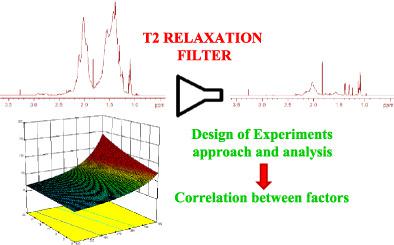当前位置:
X-MOL 学术
›
Magn. Reson. Chem.
›
论文详情
Our official English website, www.x-mol.net, welcomes your
feedback! (Note: you will need to create a separate account there.)
A multivariate approach to investigate the NMR CPMG pulse sequence for analysing low MW species in polymers
Magnetic Resonance in Chemistry ( IF 1.9 ) Pub Date : 2020-10-01 , DOI: 10.1002/mrc.5100 Federica Aiello 1 , Jan Gerretzen 1 , Marcel G Simons 1 , Antony N Davies 1, 2 , Paulo Dani 1
Magnetic Resonance in Chemistry ( IF 1.9 ) Pub Date : 2020-10-01 , DOI: 10.1002/mrc.5100 Federica Aiello 1 , Jan Gerretzen 1 , Marcel G Simons 1 , Antony N Davies 1, 2 , Paulo Dani 1
Affiliation

|
Detection and quantification of low molecular weight components in polymeric samples via NMR spectroscopy can be difficult due to overlapping signal caused by line broadening characteristics of polymers. A way of overcoming this problem could be the exploitation of the difference in relaxation between small molecules and macromolecular species, such as the application of a T2 filter by using the Carr-Purcell-Meiboom-Gill spin echo pulse sequence. This technique, largely exploited in metabolomics studies, is applied here to material sciences. A Design of Experiments approach was used for evaluating the effect of different acquisition parameters (relaxation delay, echo time and number of cycles) and sample related ones (concentration, polymer molecular weight) on selected responses, with a particular interest in performing a reliable quantitative analysis. Polymeric samples containing small molecules were analysed by NMR with and without the application of the filter, and Analysis of Variance was used to identify the most influential parameters. Results indicated that increasing the polymer concentration, hence sample viscosity, further attenuates polymer signals in CPMG experiments because the T2 of those signals tends to decrease with increasing viscosity. The signal to noise ratio measured for small molecules can undergo a minimum loss when specific parameters are chosen in relation to the polymer molecular weight. Furthermore, the difference in dynamics between aliphatic and aromatic nuclei, as well as between mobile and stiff polymers, translates into different results in terms of polymer signal reduction, suggesting that the relaxation filter can also be used for obtaining information on the polymer structure.
中文翻译:

研究用于分析聚合物中低分子量物质的 NMR CPMG 脉冲序列的多变量方法
由于聚合物的谱线加宽特性导致信号重叠,因此通过 NMR 光谱检测和量化聚合物样品中的低分子量组分可能很困难。克服这个问题的一种方法是利用小分子和大分子物种之间的弛豫差异,例如通过使用 Carr-Purcell-Meiboom-Gill 自旋回波脉冲序列来应用 T2 滤波器。这种技术在代谢组学研究中得到了广泛的利用,在这里被应用于材料科学。实验设计方法用于评估不同采集参数(松弛延迟、回波时间和循环次数)和样品相关参数(浓度、聚合物分子量)对选定响应的影响,对进行可靠的定量分析特别感兴趣。含有小分子的聚合物样品在使用和不使用过滤器的情况下通过 NMR 进行分析,并使用方差分析来确定最有影响的参数。结果表明,在 CPMG 实验中,增加聚合物浓度,从而增加样品粘度,进一步减弱聚合物信号,因为这些信号的 T2 往往随着粘度的增加而降低。当对聚合物分子量相关的特定参数时,对小分子测量的信噪比可以进行最小损失。此外,脂肪族和芳香族核之间的动力学差异,以及可移动聚合物和刚性聚合物之间的动力学差异,转化为聚合物信号减少方面的不同结果,
更新日期:2020-10-01
中文翻译:

研究用于分析聚合物中低分子量物质的 NMR CPMG 脉冲序列的多变量方法
由于聚合物的谱线加宽特性导致信号重叠,因此通过 NMR 光谱检测和量化聚合物样品中的低分子量组分可能很困难。克服这个问题的一种方法是利用小分子和大分子物种之间的弛豫差异,例如通过使用 Carr-Purcell-Meiboom-Gill 自旋回波脉冲序列来应用 T2 滤波器。这种技术在代谢组学研究中得到了广泛的利用,在这里被应用于材料科学。实验设计方法用于评估不同采集参数(松弛延迟、回波时间和循环次数)和样品相关参数(浓度、聚合物分子量)对选定响应的影响,对进行可靠的定量分析特别感兴趣。含有小分子的聚合物样品在使用和不使用过滤器的情况下通过 NMR 进行分析,并使用方差分析来确定最有影响的参数。结果表明,在 CPMG 实验中,增加聚合物浓度,从而增加样品粘度,进一步减弱聚合物信号,因为这些信号的 T2 往往随着粘度的增加而降低。当对聚合物分子量相关的特定参数时,对小分子测量的信噪比可以进行最小损失。此外,脂肪族和芳香族核之间的动力学差异,以及可移动聚合物和刚性聚合物之间的动力学差异,转化为聚合物信号减少方面的不同结果,









































 京公网安备 11010802027423号
京公网安备 11010802027423号